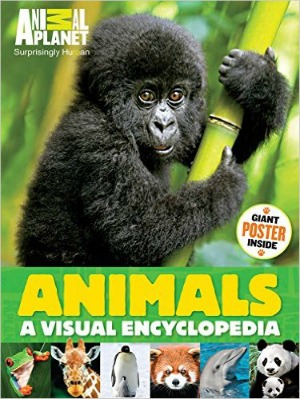
Coming in at almost 300 pages of pure information and larger than a typical textbook in overall size, Animal Planet’s Animals: A Visual Encyclopedia is a treasure to behold. In an age where any question can be answered by just a few taps on a screen, an encyclopedia seems like a throwback to another era, but I know for certain that I never came across any encyclopedia this engaging and appealing when I was a kid!
Whether your child is already an animal lover or not, this resource book is sure to be entertaining. After an introduction to the format of the book and an initial chapter on the animal kingdom as a whole, seven different classes of animals are highlighted in their own chapters. Mammals, birds, reptiles, amphibians, fish, arthropods, and other invertebrates are featured in length, with specific examples of animals in each category profiled. The page layouts include clear, close-up photographs, with each profiled animal’s section outlined in bright complementary colors.
Two specific features stand out as you browse the pages. “Fun Fact” exclamation points highlight interesting tidbits about particular animals, and as a mom, I know that children absolutely love to share newly learned facts, so be prepared to hear these read aloud! Here’s a doozy that amused my children: “Ancient centipedes were even bigger than those we know today. One found in South America measured 39 inches.” (pg. 267) Another recurring feature offers more cool info, but with the perspective of making children think about what humans and other animals may have in common. When you see the “Surprisingly Human” tag on a text box, be prepared to learn things you may not have known before about our animal brethren, such as this awesome fact: “When one magpie discovers a dead magpie, it calls loudly to attract others. Up to forty birds will gather around the body, raucously chattering. The funeral will last 10 to 15 minutes before the birds fly off silently.” (page 139) These are the types of engaging, “Wow, I didn’t know that!” facts that will appeal to young readers.
According to the publisher, more than 2,500 animals are featured in this book, and that is easy to imagine by taking a look at a typical page spread that truly utilizes as much space as possible with sharp photos and informative text. Also included is an oversized poster that can be removed from the book and hung on an animal lover’s wall, as well as QR codes right on the pages to scan for more information and extra videos so children can see the animals in action. (Don’t worry if you don’t have a QR code reader– a website address is provided as an alternative to access the videos.)
I’ve left this book out among my things for about a week now, and my children just keep picking it up to leaf through when they have spare time. My second grade son is still somewhat intimidated by long blocks of text, so the short boxes of info appeal to him, as does the intense photography. My fourth grade daughter has enjoyed looking through the index to find names of animals she’d like to learn more about– or animals she’s never even heard of!– using that to guide her reading. We haven’t yet used this resource book as an aide in homework or school projects, but I imagine that will happen sometime soon.
